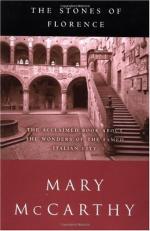
|
| Name: _________________________ | Period: ___________________ |
This test consists of 15 multiple choice questions and 5 short answer questions.
Multiple Choice Questions
1. Who painted "Stories of Saint Peter and Original Sin"?
(a) Leonardo.
(b) Andrea del Castagno.
(c) Brunelleschi.
(d) Masaccio.
2. Who performed the "egg trick" described in Chapter 5?
(a) Dante.
(b) Brunelleschi.
(c) Pope Clement VII.
(d) Donatello.
3. According to information provided in Chapter 4, which artist was posthumously considered to be "a devil"?
(a) Donatello.
(b) Andrea del Castagno.
(c) Leonardo.
(d) Titian.
4. Which Florentine does the author describe as a "zoophile"?
(a) Uccello.
(b) Ammannati.
(c) Donatello.
(d) Brunelleschi.
5. With whom did Donatello live?
(a) His mother.
(b) His sister.
(c) Brunelleschi.
(d) The Medici family.
6. According to the author, Florence shares "simplicity of life" with which city?
(a) Athens.
(b) Boston.
(c) Istanbul.
(d) Venice.
7. Where was "The Battle of San Romano" originally housed?
(a) The Uffizi.
(b) The Boboli Garden.
(c) The chambers of Pope Clement VII.
(d) The bedroom of Lorenzo de' Medici.
8. Whom does the author describe in Chapter 6 as a "tame, cruel housemouser"?
(a) Lorenzo de' Medici.
(b) Botticelli.
(c) Cosimo I.
(d) Leonardo.
9. Who created the Duomo?
(a) Arnolfo.
(b) Michelangelo.
(c) Andrea del Castagno.
(d) Donatello.
10. In what work does Milton mention Florence three times?
(a) Paradise Regained.
(b) Paradise Lost.
(c) Samson Agonistes.
(d) Areopagitica.
11. Of which biblical figure are there two statues in the Duomo?
(a) Isaiah.
(b) Noah.
(c) Moses.
(d) Paul.
12. What artist is mentioned in the first paragraph of Chapter 4?
(a) Paolo Uccello.
(b) Andrea del Castagno.
(c) Ammannati.
(d) Van Gogh.
13. Which of these artists is not mentioned in Chapter 6 as a "flowery painter"?
(a) Botticelli.
(b) Fra Angelico.
(c) Andrea del Castagno.
(d) Fra Filippo Lippi.
14. As mentioned in Chapter 5, which artists did the Romans think were searching for treasure around the ruins of ancient structures?
(a) Brunelleschi and Donatello.
(b) Uccello and Andrea del Castagno.
(c) Fra Fillipo Lippi and Uccello.
(d) Leonardo and Donatello.
15. What word did Brunelleschi use to describe the figure of Christ on Donatello's crucifix for Santa Croce?
(a) "King."
(b) "Clown."
(c) "Self-portrait."
(d) "Idiot."
Short Answer Questions
1. In the author's opinion, the work of which artist achieves Plato's ideal forms?
2. To what character in Greek mythology does the author compare the "Madonna with the Pomegranate"?
3. Who painted the Virgin Mary's head in the fresco of the Annunciation at the church Santissima Annunziata?
4. What museum in Florence does the author call "a picture gallery" in Chapter 4?
5. What Florentine church housed a respected music school in the fourteenth century?
|
This section contains 387 words (approx. 2 pages at 300 words per page) |

|




